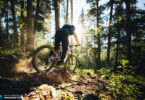You’ve got the right bike for your kid, are you ready to hit the bike park? Not so fast! Make sure you wrap your precious little ripper in gear that can handle some abuse. Check out the safety equipment we tested to help keep your day full of smiles and high-fives.
You got all our advice how to get kids started in the bikeparks? Congratulations on getting your hands on a quality bike and preparing your crew for a bit of dh action … but before you do, do they have proper protective gear? Understand that crashing is not a potential issue – it is inevitable. Not only will the kid crash, but it will take a while for them to understand the warning signs for losing control which means that the crash will often seem like a surprise. These can be dramatic crashes and terrify a little rider who is just getting comfortable on the mountain. A fearful child has no business on a dh track and this will cut your season to a quick finish no matter how much reassuring you try to do. With proper protective gear you can increase the chances that your kid can and will want to get up and throw their leg back over the saddle.


Helmets
Without a question, kids should be wearing full face helmets when riding bike parks. You will be shocked how many times they will smash the front of their helmet on the dirt. Usually the falls are not too hard but they WILL hit their face and the proper helmet will limit the damage. You have to give great consideration to the weight of the helmet though because their little necks will get tired quickly if the helmet is too heavy. Generally speaking, the more money you spend on a helmet, the lighter and more comfortable it will be. If you can not find or afford a lightweight full face helmet, then just buy a heavy one as it is more important to have the extra coverage than the weight savings.

Knee and Elbow Pads
Elbow and knee pads are a must and we recommend pads with hard plastic on the exterior for the juniors. Small stones will lead to stitches quickly and most of the time you are just trying to keep the kids safe from their own pedals. Fit is a priority so ensure that the gear does not inhibit movement or control of the bike.

Gloves
I know that many riders choose to ride without gloves these days but kids need gloves because they have a tendency to go over the bars and slide down the trail with their palms down. Your day will be over if you have to spend your afternoon picking gravel out of their hands. Buying gloves via the internet without trying them on is often a bad idea due to the fit. Some kids have short fat fingers and some kids have long skinny fingers. Without trying on the gloves you may end up wasting your money or having to chop the fingers of the glove off at the first knuckle just to get them on.

Back protection
Back protection is often not used by mature riders but should be encouraged for the little guys. Their “ragdoll” crashes lead to contact between their backs and the ground more often than your would expect. Once you’ve seen one of these crashes you will understand and be happy that the deep scratches in the plastic are only superficial.

Goggles
If you can’t see then you can’t really ride a bike, but for some reason it won’t necessarily stop a kid from trying. Dusty trails will often just cause them to close one eye. Goggles with clear lenses and fit well with their full face helmet are the best solution. Snow goggles and bike/moto goggles are made differently due to heat and airflow requirements, so make sure you choose the right goggles for the right sport.

Shoes and Pedals
Don’t forget the importance of contact points with the bike. Beginners will be riding with flat pedals so make sure that their feet are not slipping and bouncing around. Several companies are producing high quality pedals that use a composite rather than a metal body. They can be quite light, strong, and come in all kinds of crazy colors that kids love. Grip from pedals is provided by the teeth or pins that are molded or screwed into the pedal body. To test the effectiveness of the setup, place a shoe on the pedal and twist it left and right – if the shoe slips, then try another combination.

Conclusion
There are tons of products available to increase protection while riding in the bike parks, but there is a fine line between being responsible and creating additional problems. Gear must fit and not be restrictive. If any rider loses mobility or concentration due to the gear they are wearing, it can become a dangerous situation. Put on all of the gear and go for a spin around the neighborhood or local pump track to see if there are any issues because identifying problems while at the park can ruin your day or at least kill your budget when you pay full price for new gear in the shop. Rent it, borrow it, buy it … whatever your do, just make sure that when you get to the park, your most precious riding partner is ready to shred!
Did you enjoy this article? If so, we would be stoked if you decide to support us with a monthly contribution. By becoming a supporter of ENDURO, you will help secure a sustainable future for high-quality mountain bike journalism. Click here to learn more.
Words: Evan Philipps Photos: Noah Haxel, Valentin Rühl









